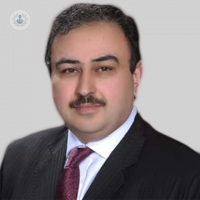Morton’s Neuroma
Written by:Morton’s neuroma is one of the most common causes of forefoot pain. Found out how you can alleviate this pain with Mr Turab Syed’s expert advice.

Morton’s neuroma is a condition where one feels symptoms of pain on the plantar aspect (sole) of the foot, with pins and needles going into the toes because of a damaged or irritated nerve in the foot.
What are the symptoms?
As well as the pain and pins and needles mentioned above, the most common symptom is patients feeling like they have a stone in their shoe, only to remove the shoe and find nothing there. In addition, patients have also commonly listed burning, tingling and numbness in toes as symptoms. Most of the time, these symptoms are felt when walking, they are not usually felt when resting or sleeping.
How does Morton’s neuroma occur?
Morton’s neuroma happens because of excessive stress placed on the foot, which causes irritation to the nerves due to rubbing, compression and/or overstretching. This results in thickening and swelling of the nerve and growth of scar tissue, which is what causes the pain.
This condition is often referred to as entrapment of the nerve between the metatarsals and most commonly found between the third and fourth toes (68 per cent of cases) or the second and third toes (32 per cent).
It is believed that the anatomy of the foot is one of the key factors in the development of Morton’s neuroma, specifically the fact that the third metatarsal nerve is thicker than the others. This means it’s more likely for rubbing to occur or for it to be squashed between the toes third and fourth toes, particularly as it’s a narrower space than between other toes. The fourth metatarsal is also much more mobile than the third, which is another factor that causes rubbing.
How is it diagnosed?
When Morton’s neuroma is suspected a doctor will check a patient’s full medical history for any signs or factors which may assist diagnosis. The doctor will then conduct a clinical examination which consists of squeezing the forefoot between the thumb and the little finger, if this action causes pain and/or a clicking sound (Mulder’s click) then Morton’s neuroma will likely be diagnosed. Scanning via ultrasound or MRI may also be used to find out the severity of the condition.
How is it treated?
Treatment options for Morton’s neuroma include both operative and non-operative measures.
Non-operative measures include:
- Metatarsal dome – This is a small soft pad which sits in your shoes, underneath your sole. These pads help alleviate the pressure on the affected area, allow the nerves to rest and reduce swelling and inflammation.
- Steroid injections – These can be performed with or with ultrasound assistance, depending on the severity of the condition and the doctor’s preference. Patients may receive up to two steroid injections and likelihood of cure has been reported at 80 per cent.
Response to steroid injections depends greatly on the size of the Morton’s neuroma. Studies have shown that cases under 5mm have a greater response at six months than bigger ones, whereas those above 6.3mm don’t tend to respond well. Despite this is always recommended to try steroid injections before undergoing surgery as it is non-invasive, reversible and doesn’t cause permanent numbness in the toes, unlike surgery. Possible side effects of surgery include tissue atrophy in the skin and hyperpigmentation.
The most common surgery for this issue is a neurectomy, where the swollen area is simply cut away from the foot. Although this permanently resolves the issue, it results in a permanent numbness of the toes, due to the nerves being cut out.
A new treatment, known as neurolysis, aims to release the inner metatarsal ligament, which presses onto the fibrotic nerve, relieving pain while allowing patients to keep the feeling in their toes.
Surgery for Morton’s neuroma has a success rate of 50-80 percent, with only a 4 per cent chance of recurrence.
What are the risks?
The potential risks of surgery include:
- Infection
- Haemotoma
- Hypertrophic scar and keloid
- Complex regional pain syndrome
- Stiffness of metatarsal/phalangeal joint
- Persistent postoperative pain
- Numbness in toes.
In cases where more than one growth is present, it is recommended that they are removed in completely separate procedures to avoid vascular damage, which can lead to further surgery.
Mr Turab Syed is a leading orthopaedic surgeon with vast experience in treating foot and ankle injuries. Request an appointment with him here.


